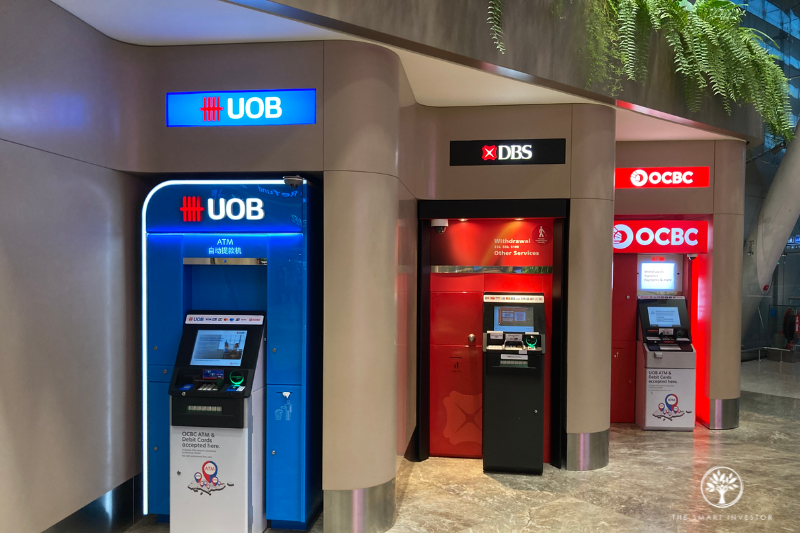Singapore’s three local banks — DBS, OCBC, and UOB — have all submitted their final report card for 2025, buoyed by resilient net interest income (NII), and strong growth in their non-NII fee businesses.
However, their share price performance has diverged, leaving investors with a familiar question: Which bank still offers the best value today?
Let’s compare the three to see which bank is the most attractively valued.
DBS Group (SGX: D05) — Premium Valuation for a Market Leader
DBS continues to lead the pack both in terms of share price appreciation and operating performance.
In particular, its earnings and return on equity (ROE) are the highest among its peers.
These metrics are testament to DBS’s market leadership position, strong digital franchise, and its proven ability to grow dividends.
For the third quarter of 2025 (3Q2025), Singapore’s largest bank achieved a record turnover of S$5.9 billion, representing a year-on-year (YoY) growth of 3%.
DBS’s net profit of S$2.95 billion declined 2% YoY compared to 3Q2024.
Commercial book NII weakened 6.3% YoY to S$3.6 billion, owing to a lower net interest margin (NIM) of 1.96%.
DBS’s loan growth of 4.5% compared to 3Q2024, amounting to S$443 billion as at 30 September 2025, helped soften the impact of lower NIM.
DBS continues to see strong momentum in its non-NII segment.
The bank’s fee income turnover of S$1.58 billion for 3Q2025, a YoY growth of 20.2%, was led by its wealth management division.
Accounting for 50.3% of its fee income business, wealth management soared 30.7% YoY to S$796 million.
More importantly, DBS raised its dividend payout to S$0.75 per share (S$0.60 in ordinary dividends and S$0.15 as a capital return dividend).
The bank’s ordinary dividend grew 11.1% compared to 3Q2024, continuing the bank’s track record of raising its payout.
Currently, DBS provides a trailing dividend yield of 5.3%.
The bank is richly valued, trading at a premium price-to-book (P/B) ratio of over 2.2 times.
With its stable funding base and a strong capital position, investors should look to DBS making continuous inroads in growing its regional presence.
Investors can expect DBS to continue delivering – however, this comes at a premium valuation.
OCBC (SGX: O39) — Strong Earnings, Softer Margins
OCBC reported stable profits, supported by higher loan volumes and insurance contributions from Great Eastern (SGX: G07), or GE.
Net profit for the third quarter of 2025 (3Q2025) of S$1.98 billion rose 9% quarter-on-quarter (QoQ).
The bank’s ROE for 3Q2025 declined to 13.4%, down from its 3Q2024 figure of 14.1%.
For the latest quarter, NIM came in at 1.84%, contributing to a YoY decline of 9% for its NII.
Similar to DBS, a bright spot for OCBC was its strong wealth management performance.
Wealth management soared 53.4% YoY to S$376 million, helping OCBC’s net fees and commissions business achieve a record turnover of S$683 million for 3Q2025.
GE also contributed S$347 million in profits, growing 50% QoQ and 37% YoY.
At a P/B ratio of around 1.4 times, OCBC has a cheaper valuation compared to DBS’s P/B of over 2.2 times.
The continuous recovery in the bank’s GE arm, a sustained increase in the demand for OCBC’s cross-border loans, and its ability to ride on ASEAN growth are factors to watch.
OCBC presents a cheaper option with its resilient earnings and diversified income streams.
UOB (SGX: U11) — Conservative and Undervalued?
UOB can be considered the most conservative local bank with its disciplined risk management.
This characteristic is evident from its decision to set aside pre-emptive general allowances of S$0.6 billion in view of economic uncertainties and sector-specific headwinds.
As a result, the bank reported a net profit of S$0.4 billion for the third quarter of 2025 (3Q2025), down 72% YoY.
This is a sharp decline compared to its second-quarter net profit of S$1.3 billion, largely owing to the pre-emptive allowances it set aside.
UOB trades at the lowest valuation for the local banks, with a P/B ratio of around 1.2 times, while offering steady dividends.
This is in contrast with OCBC’s P/B ratio of around 1.4 times and DBS’s P/B ratio of above 2.2.
Management expects NIM for 2026 to be in the range of 1.75% to 1.80%.
Strong growth in the ASEAN region, continued growth in its fee income business, and the stabilisation of interest rates, could propel the bank’s earnings moving forward.
While UOB’s prospects may lack excitement, its combination of solid fundamentals and cheaper valuation may appeal to bargain hunters.
Side-by-Side Comparison: Who’s the Cheapest?
| Bank | P/B | Trailing Dividend Yield |
| DBS | 2.2 | 5.3% |
| OCBC | 1.4 | 5.3% |
| UOB | 1.2 | 5.9% |
UOB provides the best value given that its P/B ratio is the lowest while still offering a generous 5.9% dividend yield (including special dividends).
It is also clear that, from these metrics, the market views DBS as a premium play, while OCBC and UOB are viewed more like value plays.
For investors seeking stable dividends at more attractive valuations, OCBC and UOB are your choices.
DBS represents a richer option, albeit with stronger growth prospects.
What to Watch Next
Moving forward, interest rate cuts at the tail end of 2025 through 2026 could further pressure margins and profitability for the three banks.
Watch how these banks blunt the decline in NII as they continue to grow their fee income businesses, led by wealth management.
Loan growth will also be critical in stabilising earnings.
The management teams for the three banks have guided for softer NIM and NII for 2026.
However, their fee income segments are expected to soften the blow of lower NII.
All banks also expect to continue returning capital to shareholders via steady dividends and share repurchases.
Watch out for the risks affecting all banks, including slower loan growth, an economic downturn, and possibly lower NIMs.
When rates are lowered, the banks will be tested to see which can sustain their earnings the best.
What This Means for Investors
Singapore banks remain among the most reliable dividend stocks in Singapore.
As we move into 2026, focus on these banks’ earnings sustainability and valuation supports.
UOB and OCBC offer cheaper valuations.
While DBS is richly valued, it’s a reflection of its consistent execution and stronger growth prospects.
Get Smart: OCBC and UOB Still Offer Compelling Value While DBS’s Premium Reflects Its Continued Execution
Record profits don’t always mean premium valuations — just look at OCBC and UOB.
Opportunities arise when you do the work to see which banks offer the best mix of value, yield, and resilience.
Some companies cut dividends in a downturn. These 5 didn’t.
Find out which Singapore blue chips have weathered past chaos…and why they could be your portfolio’s anchors in the next wave of downturn. Download the report free.
Follow us on Facebook, Instagram and Telegram for the latest investing news and analyses!
Disclosure: Wilson does not own shares in any of the companies mentioned





